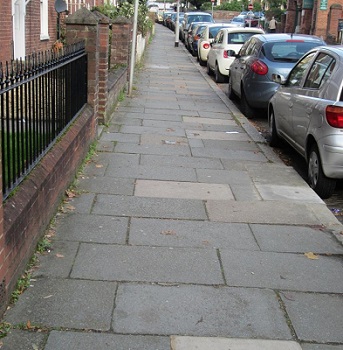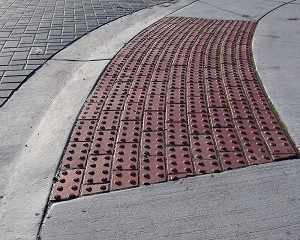Pavement
Contents |
[edit] Introduction
Pavements are a form of exterior surface covering, typically raised and used by pedestrians, running parallel to, and on either side of a road. They provide an area that is separated from, and so protected from vehicular traffic. However, the term can also be used to refer to other paved areas, such as pedestrianised streets, patios, courtyards, driveways, and so on.
Pavements can be constructed using asphalt, concrete, flagstone, cobblestone, artificial stone, bricks, tiles and timber.
The term ‘paver’ or ‘paviour’ (pavior in the USA) refers to a paving stone, tile, brick or piece of concrete used to form a pavement surface. They are usually laid to a fall of 1:60 or more to drain water to one or both sides. They are usually built to a minimum width of 1.2 m where this is possible.
The main British and European Manufacturing Standards relating to paving are:
[edit] Types of pavement
[edit] Flexible paving
This may consist of the following layers:
- 100 mm blinded and consolidated hardcore.
- 40 mm thick base course of coated macadam.
- 20 mm thick wearing course of coated macadam.
[edit] Rigid paving
This may consist of the following layers:
- 75 mm thick consolidated hardcore.
- 75 mm thick plain insitu concrete with contraction and expansion joints.
[edit] Pavers
This may consist of the following layers:
- 75 mm thick consolidated hardcore.
- 25 mm thick dry cement/sand bed.
- 600 x 600 x 50 mm precast concrete pavers laid with butt joints filled with mortar.
[edit] Small unit pavers
This may consist of the following layers:
- 100 mm thick consolidated hardcore.
- 50 mm thick bed of sharp sand.
- 60 mm thick precast concrete plain or interlocking pavers vibrated into bed with sand-filled joints.
[edit] Cobblestones
Cobblestone were frequently used in early pavement construction. They are small stones or pebbles that were traditionally gathered from stream beds and hence had been rounded and smoothed by water. They are usually set in sand or bound together with mortar.
[edit] Setts
Setts are rectangular stones, usually made of granite, often used in landscape architecture as they can be arranged in various decorative ways with different patterns and colours.
The second edition of The Dictionary of Urbanism by Rob Cowan, published in 2020, suggests that a sett is: ‘A small rectangular quarried stone used for paving. Setts are often popularily called cobbles (see cobbled). Wooden and rubber setts have also occasionally been used.'
A Belgian block is: ‘A cubical paving block; a sett’
[edit] Interlocking grids
These are concrete or stone units with open, permeable spaces between them.
[edit] Tactile paving
These come in a variety of forms and are commonly used in urban areas as a means of hazard warning for visually-impaired pedestrians at kerb edges, road crossings and gradient changes. They can also be used on cycle paths as a way of demarcating the area to be used by cyclists.
For more information, see Hazard warning surfaces.
[edit] Green paving
New products are being developed that incorporate technology with to make pavements smarter and greener. For example, see Pavegen.
[edit] Other definitions
The second edition of The Dictionary of Urbanism by Rob Cowan, published in 2020, suggests that pavement can mean:
- '(UK) The raised surface for pedestrians beside a street or road. The US equivalent is sidewalk, though pavement is used in some parts of the southern states.
- (US, and UK highway engineers) The structure of a road, including its surface and underlying foundations. The general UK equivalent is roadway.
- A paved surface.
- An alley.
From the Latin pavire, to beat hard.'
[edit] Related articles on Designing Buildings
- Binder course.
- Bitumen binder may delay road surface deterioration.
- Bituminous mixing and laying plant.
- BREEAM Hard landscaping and boundary protection.
- Britain's historic paving.
- Capping layer.
- Coal holes, pavement lights, kerbs and utilities and wood-block paving.
- Code of Practice for Ironwork Systems Installation and Refurbishment.
- Glossary of paving terms.
- Groundwater control in urban areas.
- Hazard warning surfaces.
- Highway drainage.
- Hoggin.
- How to lay block paving.
- Kerbs.
- Landscape design.
- Overview of the road development process.
- Pavegen.
- Pedestrianised.
- Permeable pavements.
- Pervious pavement.
- Road construction.
- Types of road and street.
- Vicars' close.
- Walkway.
[edit] External references
- ‘Building Construction Handbook’ (6th ed.), CHUDLEY, R., GREENO, R., Butterworth-Heinemann (2007)
Featured articles and news
Professional practical experience for Architects in training
The long process to transform the nature of education and professional practical experience in the Architecture profession following recent reports.
A people-first approach to retrofit
Moving away from the destructive paradigm of fabric-first.
International Electrician Day, 10 June 2025
Celebrating the role of electrical engineers from André-Marie Amperè, today and for the future.
New guide for clients launched at Houses of Parliament
'There has never been a more important time for clients to step up and ...ask the right questions'
The impact of recycled slate tiles
Innovation across the decades.
EPC changes for existing buildings
Changes and their context as the new RdSAP methodology comes into use from 15 June.
Skills England publishes Sector skills needs assessments
Priority areas relating to the built environment highlighted and described in brief.
BSRIA HVAC Market Watch - May 2025 Edition
Heat Pump Market Outlook: Policy, Performance & Refrigerant Trends for 2025–2028.
Committing to EDI in construction with CIOB
Built Environment professional bodies deepen commitment to EDI with two new signatories: CIAT and CICES.
Government Grenfell progress report at a glance
Line by line recomendation overview, with links to more details.
An engaging and lively review of his professional life.
Sustainable heating for listed buildings
A problem that needs to be approached intelligently.
50th Golden anniversary ECA Edmundson apprentice award
Deadline for entries has been extended to Friday 27 June, so don't miss out!
CIAT at the London Festival of Architecture
Designing for Everyone: Breaking Barriers in Inclusive Architecture.
Mixed reactions to apprenticeship and skills reform 2025
A 'welcome shift' for some and a 'backwards step' for others.



























